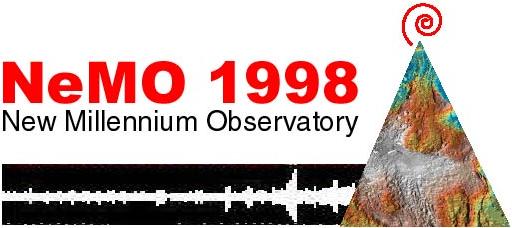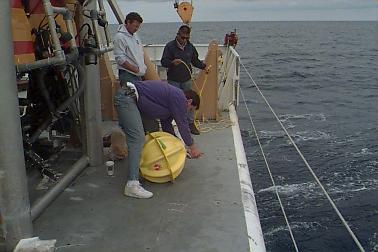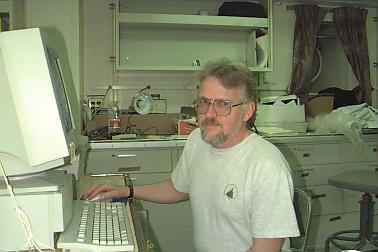WHAT'S NEW:
This Page's Debut
(posted 7/20/98)
BACKGROUND:
Technology (ROV, ships, etc.)
EXPEDITION:
Cruise
Plan
Calendar
Today's Science News
Participant Perspective
Teacher Logbook
EDUCATION:
Curriculum
Teacher Observations
Questions/Answers from sea

Logbook
August 26, 1998
August 26, 1998
Contents:
Science Report
August 26, 1998

Science activities:
Dropped the transponders (8 of them) and calibrated the transponder nets (3 separate nets: north rift zone, ashes, and south rift zone). (See NeMO map for these areas). Looks like we will be done with the calibration by late morning, then if all goes well we will be ready for our first ROPOS dive. Plans call for SUAVE to be aboard the first dive collecting samples.
Listing of all Science News postings
Life at Sea: Participant Perspective
Personal Perspective:
Bob Embley, Chief Scientist

Hi Everyone, I'm Bob Embley, Chief Scientist of the first NeMO expedition. As I write this I can't help reflecting on how much has changed in oceanography since my first expedition 32 years ago. My first cruise on the VEMA in 1966 circled the North Atlantic taking samples and measurements over thousands of miles during the course of almost 6 months. Over the years there has been a steady increase in complexity of the tools that scientists bring on board research vessels in parallel with the sophistication of the vessels themselves. The RON BROWN is one of four state-of-the-art oceanographic vessels built in the 1990s with has capabilities almost unheard of 30 years ago. As an example, it can hold station over a spot on the seafloor with an accuracy of about 5 meters (~16 feet)! In 1966 we were fortunate at any given time to know our position within about half a mile!
You're probably wondering what a "Chief Scientist" does on an expedition like this. First, I should say that this is probably the most complex expedition I've ever been involved in. My colleagues and I have spent the last two years preparing for it! First, we had to develop the NeMO concept. Then we had to write "proposals", wherein we presented our scientific ideas and requested money to support the research. After that came the task of ensuring that we had access to both the RON BROWN and the ROPOS at the same time. So really the job of chief scientist starts long before the cruise begins. Now that we're at sea, I'm the primary contact person between the scientific party, the ship, and the ROPOS group. My job is mostly coordinator of the science program, making sure that everyone has a good chance to accomplish the goals stated in their proposals. Since there are 33 in the science party (the most I've ever been at sea with previously was about 25), this can be an interesting experience! In addition, I have my own scientific goals which are aimed at a better understanding of how mid-ocean volcanos form and interact with the ocean.
Tonight we are laying in "transponders", which are sound-emitting beacons placed on the seafloor to provide ROPOS with its location while its operating on the seafloor. Soon after we complete that sometime tomorrow afternoon, ROPOS will descend to the top of Axial Volcano for the first time. In February, I was on the first cruise to the site on the research vessel WECOMA after the "event". We measured large temperature anomalies in the water overlying the volcano but could not visit the seafloor. The brief view I had of the site in July from the porthole of the submersible Alvin revealed a volcanic landscape covered in places with large areas of bright white bacterial mat and warm water gushing from uplifted slabs of lava. Now we are poised over the volcano with ROPOS, whose lights, cameras, and specialized instrumentation will bring this unique group of biologists, microbiologists, chemists and geologists to this unique environment for the the next several weeks. Even though the ship will not move more than a few miles, I'm sure this journey will take me to at least as many interesting places as I visited on that first expedition more than 30 years ago.
All of us out here on the RON BROWN are looking forward to sharing this journey with you.
Listing of all Perspectives postings
Teacher At Sea Logbook
August 26 - 0800 hours
360 degrees around the ship, nothing but water. No land anywhere. That's a strange feeling for those of us who spend most of our lives strolling around on solid land. Speaking of solid land, let me give you just a little background on where we are going and why we are going there. People who live along the west coast of North America, at least those who live north of California, are just becoming aware of the very real potential for a huge earthquake in this area. There is plenty of evidence of such earthquakes in the past, and its been several hundred years since the last one. Directly under our ship is the Axial Volcano. It is part of a huge and complex system of geologically active areas called mid-ocean ridges. Axial Volcano is producing new ocean floor, and in the process is setting up a strain in the oceanic crust that will eventually drive the leading edge of the ocean crust under North America. The result could easily be an earthquake that would exceed 8.5 on the Richter Scale. We are here to try to better understand that process. We are also here to try to understand more about the biology, chemistry and physics of these vent systems.
1600 hours
We just deployed one of the first and most important scientific instruments. It is the transponder. The transponders are the scientist's eyes and ears on the sea floor. Transponders tell the scientists exactly where ROPOS is at any time. This is absolutely essential in order to keep the multi-million dollar device clear of the many dangers that lurk in the dark waters of the vent area. The external surfaces of the ROPOS show a fair number of dents and scrapes that attest to earlier close calls.
The transponder is a relatively simple piece of equipment. A radio transmitter and receiver are placed inside two amazingly thin glass hemispheres. (note correction later on 9/8 teacher log...not "radio"!) Some of the air is pumped out of the sphere. This holds the two halves together. A plastic cover then protects the whole sphere from bumping into solid objects on the deck of the ship while the transponder awaits deployment. A transducer attached to the top of the whole structure emits and receives radio signals at frequencies that are different for each transponder. Another transponder attached to the ROPOS cage and a slave unit attached to the ROPOS itself constantly send signals back and forth. By simple triangulation (similar to the way earthquake epicenters are determined by seismologists) the scientists are able to locate the ROPOS and direct its movement over the ocean floor.
Hopefully as early as Friday or Saturday we will begin to see high resolution color video shots direct from the vent zone. I encourage all students and teachers to link to the ROPOS web site to find further information about this phenomenal piece of engineering. We will be taking a closer look at the ROPOS as well as the data and samples it collects throughout the voyage.
I should mention that I personally lost much of today after two seasickness pills put me into the ozone. I was not alone. Many experienced ocean people were green around the gills. For most people the symptoms last one or two days. I vote for one! There is a price to be paid for being on the cutting edge of marine science. It is a price worth paying. Beginning tomorrow I will be spending four hours each day helping scientists in the labs. Check back with this site to see what new discoveries are hidden tonight on the cold sea floor 1400 meters below the Ronald Brown.
Gene
Logbook of all Teacher At Sea postings
Question/Answer of the Day
Send Your Question to NeMO
Back to Calendar